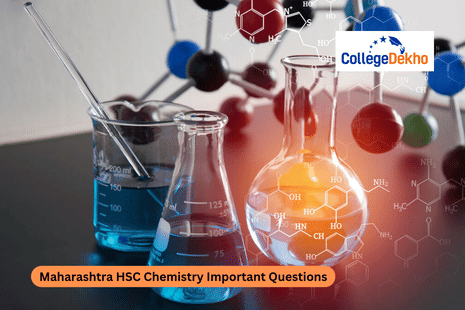

Never Miss an Exam Update
Maharashtra HSC Chemistry Important Questions 2026 : The Chemistry syllabus has three parts, Physical Chemistry, Organic, and Inorganic Chemistry where Thermodynamics, Electrochemistry, Coordination Compounds, Alcohols, Phenols, and Ethers, Biomolecules, Polymers, Chemical Kinetics, and Organic Chemistry are some of the key chapters. Apart from this, Aldehydes, Ketones, and Carboxylic Acids, Structure and Bonding, Reaction Mechanisms, and Nomenclature are also important. You also need to focus on solving numerical problems related to various topics like stoichiometry, solutions, electrochemistry, and kinetics. Practice the Maharashtra HSC Chemistry Previous Year Question Papers as well as the sample papers within the time given to improve speed and accuracy. Continue reading the article to have more details on Maharashtra HSC Chemistry Important Questions 2026.
Maharashtra HSC Chemistry Important Questions 2026 of 1 Mark
The 1 marks questions will be there in the first section where there will be 10 multiple choice type of questions and 8 very short answer type of questions. Each will be compulsory. Based on the last few year question papers, we have provided some of the Maharashtra HSC Chemistry Important Questions 2026:
- A First order reaction is 50% complete in 69.3 minutes. Time required for 90% completion for the same reaction is a) 100 b)125 mins c) 230 mins d) 230.3 mins
- The rate law relates to the rate of a chemical reaction in terms of _____ a) Concentration of catalyst b) Temperature c) Potential energy d) mol/L of reactants
- The pH of weak monoacidic base is 11.2, its OH– ion concentration is: (A) 1.585 × 10 –3 mol dm –3 (B) 3.010 × 10 –11 mol dm –3 (C) 3.010 × 10 –3 mol dm –3 (D) 1.585 × 10–11 mol dm –3
- Sugar dissolves in water because a) sugar is nonpolar b) water is polar c) sugar and water are both polar d) it forms hydrogen bonding with water
- The colligative properties of solutions a. depend on nature of solute particles b. do not depend on number of solute particles c. do not depend on dissociation of solute in solvent d. depend on number of solute particles
- The Henry’s law constant of a gas is 6.7×10 -4 mol/(L bar). Its solubility when the partial pressure of the gas at 298 K is 0.65 bar is.. a.4.355×10 -4 mol/L c. 2.225×10 -6 mol/L b. 4.355×10-2mol/L d. 2.225×10 -2 mol/L
- The linkage present in Lactose is (a) a, B-1, 2-glycosidic linkage (b) a-1, 4 - glycosidic linkage (c) B-1, 4-glycosidic linkage (d) a -1, 4- glycosidic linkage
- An intensive property amongst the following is ________ a) Mass b) c) Number of moles Volume d) Temperature
- Kohlrausch law is applicable for ___________ a) the solution at infinite dilution c) concentrated as well as dilute solution b) a concentrated solution d) aqueous solution
- During electrolysis of molten NaCl, which of the following statement is Incorrect? a) a pale green Cl2 gas is released at anode b) molten silvery white sodium is deposited at cathode c) decomposition of NaCl into Na metal and Cl2 gas d) a pale green Cl2 gas is released at anode
- When molten ionic compound is electrolyzed a metal is formed at ________ a) Negative electrode b) Positive electrode c) Salt bridge d) Electrolyte
- Write the name of metal nanoparticle used to remove E.coli bacteria from water.
- Write the name of reduction product formed when ethyl cyanide is treated with sodium and alcohol.
- Calculate effective atomic number of [Co (NH3)6]3+ ion.
- What is cryoscopic constant?
- State Henry's law.
- What type of solutions exhibit positive deviations from Raoult’s law?
- Write SI unit of molar conductivity.
- Write the name of the product formed by the action of LiAlH4/ ether on acetamide.
- Write the structure of the product formed when chlorobenzene is treated with sodium metal in the presence of dry ether.
- Write the chemical composition of cryolite.
- Calculate molar conductivity for 0.5 M BaCl2 if its conductivity at 298K is 0.01 Ω–1 cm –1.
- Write the product formed when alkyl halide reacts with silver nitrite.
- Write the name of product formed, when acetone is treated with 2, 4-dinitrophenyl hydrazine.
- Write the name of the alloy used in Fischer Tropsch process in the synthesis of gasoline.
- Henry's law constant for CH3Br(g) is 0.159 mol dm3 bar¹ at 25°C. What is solubility of CH3Br(g) in water at same temperature and partial pressure of 0.164 bar?
- Identify the molecularity of following elementary reaction: NO(g) + O 3 (g) → NO 3 (g) + O(g)
Maharashtra HSC Chemistry Important Questions 2026 of 2 Marks
Section B contains 2 marks 12 short answer type of questions out of which you need to answer only 8 questions. Few predicted Maharashtra HSC Chemistry Important Questions 2026 of 2 marks are:- Distinguish between ideal and non-ideal solutions
- Define the terms: (i) Standard enthalpy of combustion (ii) Enthalpy of sublimation.
- State and explain Hess's law of constant heat summation.
- Calculate the standard enthalpy of combustion of CH 4 (g) if ∆f H 0 (CH 4 ) = -74.8 kJ mol-1, ∆ fH 0 (CO 2 ) = -393.5 kJ mol-1 and ∆ f H 0 (H2O) =-285.8 kJ mol -1
- Draw a neat and labeled diagram of Standard Hydrogen Electrode.
- What are the functions of a salt bridge in a galvanic cell?
- Write applications of Kohlrausch’s Law.
- What is the cell constant? Write its SI unit.
- Mention difficulties in setting Standard Hydrogen Electrode.
- Represent the galvanic cell from following overall cell reaction Cd (s) + Cu 2+ (aq) → Cd 2+ (aq) + Cu (s)
- Write classification of ligands with one example of each type. 2) Define following terms (i) Coordination isomer (ii) Hydrated isomers.
- Draw a neat and labeled diagram of Lead accumulator.
- Draw a neat and labeled diagram of Leclanche cell (Dry Cell)
- Write Classification of aliphatic ketones with suitable example.
- What is the action of Grignard reagent on benzonitrile?
- Carboxylic acids have higher boiling points than those of ethers. Give reason.
- Explain Cannizzaro reaction with suitable examples
- Explain preparation of glucose form sucrose
- Write chemical reaction for following conversions a) glucose into glucoxime b) glucose into gluconic acid
- Define peptide bond. Write types of proteins depending upon molecular shape.
- Define the following terms. a) nucleotide v) Explain denaturation of proteins b) nucleoside
- Explain the trends in the following atomic properties of group 16 elements: (i) Atomic radii (ii) Ionisation enthalpy (iii) Electronegativity (iv) Electron gain enthalpy
- Write chemical composition of haematite. Write the names and electronic configurations of first two elements of group 17.
Maharashtra HSC Chemistry Important Questions 2026 of 3 Marks
- Derive the expression for molar mass of solute in terms of boiling point elevation of solvent.
- Explain the phenomenon of osmosis with a suitable diagram.
- Explain with the help of vapor pressure-temperature curves for solution and solvent, why boiling point of solvent is elevated when a nonvolatile solute is dissolved into it.
- A solution containing 3 g of solute A (M=60 g/mol) in 1L solution is isotonic with a solution containing 8.55 g of solute B in 500 mL solution. What is the molar mass of B?
- Derive an integrated rate law expression for first order reaction: A → B + C
- Define molecularity. The rate constant of the first order reaction is 1.386min-1. Calculate the time required for 80% reactant to decompose?
- a.Define an isolated system. b.Three moles of an ideal gas are expanded isothermally from 15 dm3 to 20 dm3 at constant external pressure of 1.2 bar, calculate the amount of work in Joules.
- Define the following terms: (i) Enthalpy of vaporization (ii) Standard enthalpy of combustion. Why is work done in vacuum zero
- State Kohlrausch law of independent migration of ions. Derive the relationship between Gibbs energy of cell reaction and cell potential.
- Write the main difference between electrolytic conductivity and molar conductivity with respect to concentration. Also write one application of electrochemical series.
- Write three important steps required to determine molar conductivity.
- Draw a neat and well labeled diagram of Standard Hydrogen Electrode. Write one application.
- Write reactions for the following conversions. a. Benzene to Benzaldehyde b. Propanone to Propane c.4-Nitrobenzoic acid to Nitrobenzene
- Write IUPAC name of mesityl oxide. What is the action of following reagents on acetaldehyde? a. hydroxylamine b. acidified potassium dichromate
- Write chemical reactions to convert –COOH group of acetic acid into following a. CH4 b. C2H5OH c. CH3COCl
- Define carbohydrates. Draw the Haworth projection structures of the following. a) α-D-(-) fructofuranose b) maltose
- Explain D and L configuration in sugars. Write a chemical reaction to convert glucose into glucose cyanohydrin.
- Define α- amino acids. Draw the structures of a) Zwitterion of alanine b) Haworth formula of sucrose.
Maharashtra HSC Chemistry Important Questions 2026 of 4 Marks
- What are non-ideal solutions? Explain with reasons and diagrams the positive and negative deviations from Raoult’s law shown by non-ideal solutions.
- Define following terms a) Reverse Osmosis b) Semi permeable membrane c) Osmotic pressure d) Isotonic solution.
- Define the following terms:(i) Enthalpy of atomization (ii) Extensive properties Write mathematical statement of first law of thermodynamics for following processes a) Isothermal process b) adiabatic process.
- In a first order reaction A → B, 60% of a given sample of a compound decomposes in 45 mins. What is the half-life of a reaction? Also write the rate law equation for the above first order reaction. (Ans: t1/2 = 34.02min)
- Classify the following into intensive and extensive properties. Pressure, volume, mass, temperature. Define state function and write two examples of it.
- Write sign conventions of W and Q Calculate the standard enthalpy of the reaction
- Why is the Nickel Cadmium cell referred to as a secondary cell? Write working of NICAD storage cells. Write its applications.
- Write relation between electrolytic conductivity and molar conductivity. Calculate molar conductivity at zero concentration for CaCl 2 and NaCl. Given: molar ionic conductivities of Ca 2+ , Cl - , Na + ions are respectively, 104, 76.4, 50.1 Ω -1 cm-2mol -1
- Draw structure of salicylaldehyde. Write reaction for preparation of acetophenone from benzoyl chloride. Explain the acidic nature of carboxylic acids.
- Write reactions for the action of following reagents on p-chlorobenzaldehyde. a) Ethane-1,2-diol in presence of dry HCl. b) Tollen’s reagent. c) Phenyl hydrazine
- Define carbohydrates. Give the classification of carbohydrates with example.
- What is monosaccharide? How is glucose prepared on a commercial scale? Draw the structure of pyran.
For the Maharashtra HSC Chemistry exam, the important topics that you must emphasize more on are the Solid State, Solutions and Colligative Properties, and Organic Chemistry topics like Haloalkanes, Alcohols, Phenols, and Ethers. Inorganic Chemistry, especially elements of Groups 16, 17, and 18, and topics like Thermodynamics, Electrochemistry, and Coordination Compounds. Try to complete the netire syllabus on time and solve more question papers.
Are you feeling lost and unsure about what career path to take after completing 12th standard?
Say goodbye to confusion and hello to a bright future!

Was this article helpful?



















